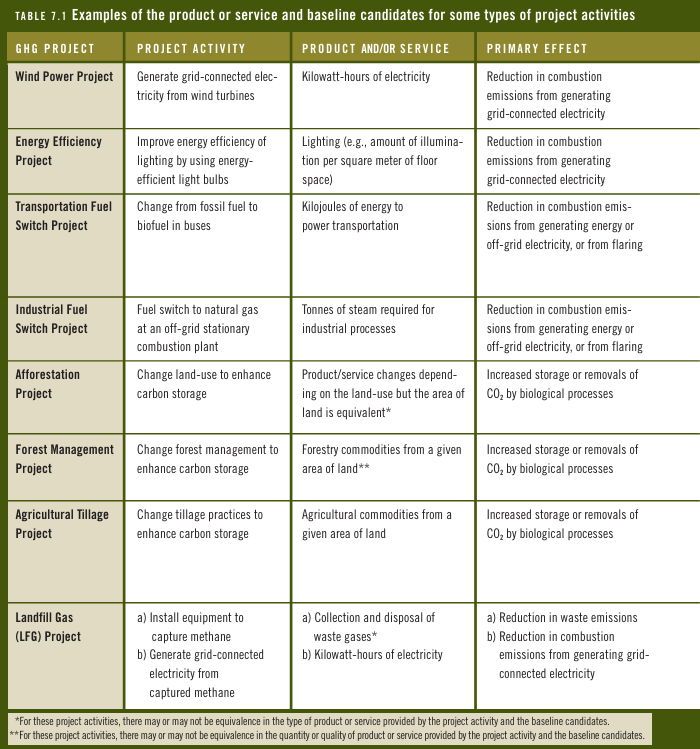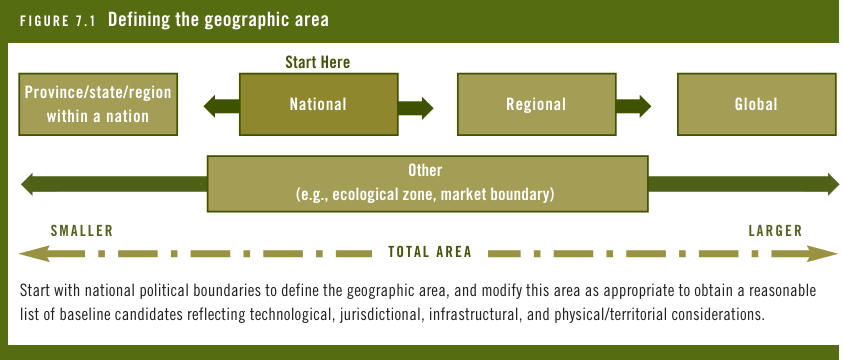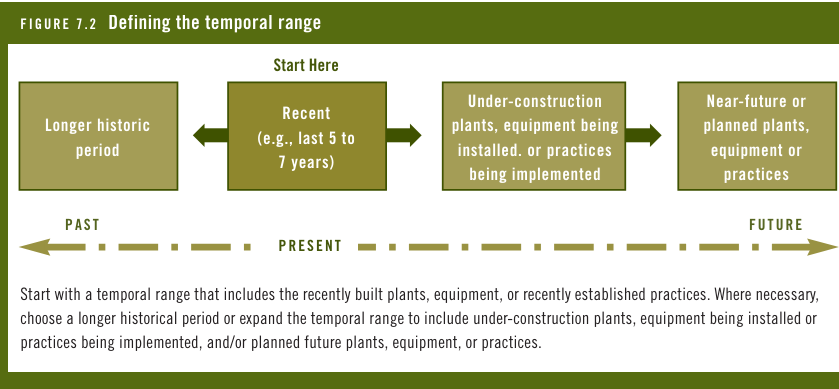Guidance
When figuring out the list of baseline candidates for a project, it’s not a straightforward process. It involves going through steps in a certain order, but you might need to go back and forth between them. Balancing the thoroughness of the process with the available resources is crucial, and if you have to make compromises, it’s best to be clear about them.
A. Defining the Product or Service Provided by the Project Activity
- Baseline Candidates Definition: Baseline candidates are things that offer the same product or service as the project you’re working on. They’re essentially similar or nearly identical.
- Clear Product or Service Definition: To find these baseline candidates, it’s crucial to first very clearly define what your project is making or doing. This could be a product or a service.
- Varied Forms of Products/Services: The product or service can come in different shapes and sizes, depending on the type of project. Sometimes, it might not be immediately obvious what the product or service is.
- Narrow Definition: It’s recommended to define the product or service quite narrowly, focusing only on the immediate outputs directly linked to the project. Don’t include things that are part of a larger system or facility unless your project is the entire system.
- Caution about Larger Facilities or Systems: Be careful not to mistakenly identify a product or service that is actually provided by a bigger facility or system of which your project is just a part.
- Example Illustration: For instance, if your project involves using a cleaner fuel in vehicles instead of a polluting one, the service provided would be the energy for transportation, not the transportation itself. So, alternative fuels could be considered as baseline candidates, but alternative modes of transportation would not.

B. Identifying Possible Types of Baseline Candidates
- Identifying Baseline Candidates: To find possible baseline candidates, think broadly about alternatives that offer a similar product or service as your project. This information is often organized in Table 7.1.
- Guiding Questions: Here are some questions to guide your thinking:
- Alternative Technologies and Practices: What other technologies, management methods, or production practices could provide similar products or services?
- Industry Standards: What methods do others in the industry use to offer the same product or service?
- Common Systems: What’s the usual way of managing, producing, or delivering products/services in the market your project targets?
- Status Quo: What are the current, standard technologies, practices, or systems in use?
- Alternative Technologies and Practices: What other technologies, management methods, or production practices could provide similar products or services?
- Same Product or Service Requirement: For both project-specific and performance standard procedures, baseline candidates should ideally offer the exact same product or service as your project. There might be exceptions, but they should be limited.
- Comparability Exceptions: In some situations, baseline candidates might provide a product or service that is comparable but not identical. For example, different lighting technologies might have varying characteristics. However, these exceptions should be carefully considered, and the availability and nature of substitute products or services should be taken into account.
- Transparency is Key: To be transparent, project developers should clearly explain when and why the product or service provided by baseline candidates might not be the same as the project activity. This helps everyone understand the choices made.
C. Defining the Geographic Area and Temporal Range
- Developing Baseline Candidates List: When creating the final list of baseline candidates, it’s crucial to identify specific types of candidates within a certain geographic area and time frame relevant to your project.
- Geographic Area and Temporal Range: The geographic area is the physical location, and the temporal range is the specific time period considered. These should be chosen carefully.
- Key Criterion: Diversity and Sufficiency: The main rule for picking the geographic area and temporal range is that they should have enough different baseline candidates. This is important for a credible analysis and estimate of baseline emissions.
- Guidelines for Area and Range: If following the initial guidelines results in too few baseline candidates, you might need to make the area or range larger. For instance:
- Temporal Range Expansion: If there aren’t enough baseline candidates in the chosen time frame, you might need to include newer plants, equipment being installed, or emerging technologies and practices.
- Geographic Area Expansion: If the chosen area doesn’t have sufficient baseline candidates, consider expanding to include other areas with similar circumstances to your project.
- Temporal Range Expansion: If there aren’t enough baseline candidates in the chosen time frame, you might need to include newer plants, equipment being installed, or emerging technologies and practices.
- Considerations for Expansion: The expansion might involve including areas with similar technological, resource, socioeconomic, or political conditions.
- Iterative Process: Figuring out the right geographic area and temporal range might not happen in one go. It’s often an iterative process, meaning you might need to go back and make adjustments based on what you find during the analysis.
Defining the Geographic Area:

- What is Geographic Area? :
It’s about deciding where the plants, equipment, or practices you’re studying are located. - Starting Point:
Begin by considering national political boundaries. You might adjust this based on your project’s circumstances. - When to Go Narrow or Wider? :
Depending on your project and baseline candidates, you might want a narrow area (like a state or electricity grid) or a wider one (like an international region). - Guidelines for Area Definition:
- Mature Technology or Practice: If the technology or practice is widespread or rapidly becoming similar everywhere, a regional or global area might be best.
- Human-Influenced Factors: If factors influenced by people (like laws or cultural practices) affect baseline candidates, consider administrative boundaries.
- Physical Infrastructure Constraints: If physical infrastructure (like power grids) is vital, use an area that represents the extent of that infrastructure.
- Biophysical Characteristics: If things vary due to natural features (like climate or soil), use a representative ecological zone.
- Mature Technology or Practice: If the technology or practice is widespread or rapidly becoming similar everywhere, a regional or global area might be best.
- Factors to Consider:
Transparency and relevance should guide your choice. What makes sense for your project?
Defining the Temporal Range:

- What is Temporal Range?:
It’s about picking the right time period to look at when selecting baseline candidates. - Factors for Temporal Range:
- Recently Built or Established: It’s good to start with recent plants, equipment, or practices (like the last 5 years).
- Under-Construction or Being Installed: Although harder to find data for, they show trends better than existing candidates.
- Planned Future Projects: If used, rely on published government or company plans for larger projects.
- Recently Built or Established: It’s good to start with recent plants, equipment, or practices (like the last 5 years).
- Guidelines for Temporal Range:
- Dominant Technology or Practice: If one thing dominates and hasn’t changed much, use a longer temporal range.
- Many Alternatives: If there are many options, use a longer range to capture the variety.
- Rapidly Changing Technology: If technology is changing fast and the sector is mostly using it, use a shorter range.
- Policy or Legal Changes: If there’s a significant policy or legal change, use a range that covers that period.
- Dominant Technology or Practice: If one thing dominates and hasn’t changed much, use a longer temporal range.
- Emission Rates Consideration: If you have data on emission rates, use trends to decide the temporal range.
- Factors to Consider: Just like with the geographic area, transparency and relevance are crucial. What works best for your project’s circumstances?
D. Defining Other Criteria Used to Identify Baseline Candidates
Baseline Candidates and Legal Requirements:
- Legal Requirements as a Guide: Legal rules and common practices can help identify baseline candidates and guide how we define the geographic area and temporal range.
- Baseline Candidates and Enforced Laws: If there are laws or regulations affecting baseline candidates, the chosen geographic area should align with the jurisdiction where these laws apply. The temporal range shouldn’t extend before the date covered by these laws. This ensures that only candidates complying with the regulations are considered.
- Consideration When Laws are Not Enforced: If laws are not enforced, using legal jurisdictions or enactment dates might not be suitable. In such cases, it’s important to document the lack of enforcement.
- Relevant Legal Requirements: These include national, state, provincial, or local regulations or laws affecting greenhouse gas (GHG) emissions. It could involve using specific technologies, meeting performance standards, or adhering to certain criteria or practices.
- What Legal Requirements Should Include: Only include laws that have been passed, enacted, and are being enforced. Voluntary agreements, laws under discussion, and general government policies that aren’t mandatory should generally be excluded.
- Compliance with Legal Requirements: Baseline candidates comply with legal requirements if there are no applicable mandatory laws or regulations in the defined area and timeframe, or if the technology or practices meet all the conditions prescribed by existing and enforced laws.
- Challenges in Defining Legal Requirements: Challenges may include unclear or contradictory laws, how to handle pending legislation, varying enforcement levels, and laws applying to different regulatory jurisdictions.
- Transparency in Decision-Making: If legal requirements are used to set constraints, transparency is key. Project developers should explain how they decided which legal requirements to consider.
Baseline Candidates and Common Practice:
- Common Practice as a Guide: In some cases, it might be a good idea to exclude baseline candidates with higher GHG emissions than those considered “common practice.” This is particularly relevant when using the project-specific procedure for estimating baseline emissions.
- Understanding Common Practice: Common practice refers to the technologies or practices that are widely used in a specific market. This is determined by the degree to which these technologies or practices have penetrated the market in a specified geographic area.
- Calculating Common Practice Penetration: Collect data on all baseline candidates in the area, and calculate the percentage for each technology or practice. This percentage can be based on the number of plants using each technology or practice, or it could be weighted by the proportion of the total output attributed to each technology or practice.
- Common Practice and Market Share: The level of penetration representing common practice may vary between sectors and geographic areas. For example, a certain technology might have a 60% market share in one area and a 15% market share in another but could still be considered common practice in both instances.
- Factors Influencing Common Practice: The diversity of baseline candidates within a geographic area can affect what is considered common practice. In areas with many alternatives, even a lower market share might be considered common practice.
- Relationship with Legal Requirements: Common practice technologies or practices might align with legal requirements, but they might not always correspond.
E. Identifying the Final List of Baseline Candidates
Relationship Between Baseline Candidates and Baseline Procedures:
- Different Procedures, Different Numbers: The number of baseline candidates and how they’re defined can vary depending on the method used to identify baseline emissions.
- Performance Standard vs. Project-Specific Procedure:
- Performance Standard: All plants, instances of a technology, or practices providing the same product or service as the project activity are baseline candidates.
- Project-Specific Procedure: Usually involves a more limited number of individual instances or representative types of plants, technologies, or practices.
- Performance Standard: All plants, instances of a technology, or practices providing the same product or service as the project activity are baseline candidates.
- Example: Let’s say there are six plants making the same product as the project activity, three using Technology X (A, B, C), two using Technology Y (D, E), and one using Technology Z (F).
- For Performance Standard: All six individual plants (A, B, C, D, E, F) are baseline candidates.
- For Project-Specific Procedure: The baseline candidates could be the representative technologies X, Y, and Z.
- For Performance Standard: All six individual plants (A, B, C, D, E, F) are baseline candidates.
- Defining Representative Types: For the project-specific procedure, representative types of technologies or practices need careful definition. This might include choosing an individual plant or instance or defining a representative type using average performance characteristics or GHG emissions from multiple plants.
- Wide Variations in Performance: Some technologies may vary widely in performance. For example, coal-fired boilers can have different fuel-use efficiencies. In such cases, baseline candidates might be defined for different performance levels or specific makes and models of the technology.
- Equivalent Quantity Requirement: Each baseline candidate in the project-specific procedure should be capable of providing an equivalent quantity of product or service as the project activity. This might mean grouping similar smaller plant technologies or practices that, together, provide an equivalent quantity of product or service.
Selecting a Final List:
- Criteria for Final List: The final baseline candidates, used for estimating baseline emissions, should be within the defined geographic area and temporal range. They must also provide the same product or service as the project activity.
- Principles to Follow:
- Completeness: Make sure all relevant baseline candidates are considered.
- Relevance: Baseline candidates should be related to the project activity.
- Transparency: The process of identifying baseline candidates should be clear and open.
- Completeness: Make sure all relevant baseline candidates are considered.
- Documentation: Before starting baseline procedures, document the final list of baseline candidates, their characteristics, and how they were identified within the chosen geographic area and temporal range.
- Large Number of Candidates: If there are many baseline candidates in the defined area and range, statistical sampling might be used to choose the final list. This process should be fully described and explained.

F. Identifying the Baseline Candidates that Represent Common Practice
If Using the Project-Specific Procedure:
- Goal: When using a method called the “project-specific procedure” to figure out baseline emissions, project developers should pinpoint baseline candidates that represent what is commonly done in the industry. This is what we call “common practice.”
- Guidance for Identifying Common Practice:
- The advice given above provides guidance on how to define common practice technologies or practices.
- Common practice refers to what is widely done in a specific market, based on the technologies or practices that have become quite prevalent.
- The advice given above provides guidance on how to define common practice technologies or practices.
- Explaining Challenges: If there are situations where it’s tough to define what is considered common practice, project developers should clearly explain why. This could be due to unique circumstances or a lack of clear patterns.
If Using the Performance Standard Procedure:
- Difference in Approach: If project developers are using a different method called the “performance standard procedure” to estimate baseline emissions, there’s a difference in the approach.
- Common Practice Identification Not Needed:
- In this case, it’s not necessary to specifically identify baseline candidates that represent common practice.
- This is because, in the performance standard procedure, the rates at which different baseline candidates are adopted in the market (and what is considered common practice) are directly reflected in the baseline emission rate calculated using that procedure.
- In this case, it’s not necessary to specifically identify baseline candidates that represent common practice.
- Why the Difference? : The procedure itself, in this case, inherently considers and accounts for what is commonly done in the industry. So, there’s no separate need to identify common practice candidates.


